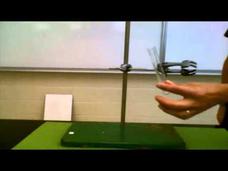Amoeba Sisters
General Lab Safety
From horseplay to hair length, here's a video that covers all your lab safety needs! Animated characters present a fun yet functional resource geared toward all science disciplines. Topics include safety equipment, proper lab etiquette,...
Crash Course
Lab Techniques and Safety
Lab safety, lab safety, lab safety: you can't say it enough! A video demonstrates the essentials for being safe whether in a chemical or biological lab. Learn the techniques to keep you and your classmates safe all year, from activity...
Fuse School
Green Chemistry - Principle 5
How important is lab safety, anyway? And, how do chemical manufacturers create safe lab environments? Chemistry scholars learn the importance of minimizing risks where the stakes are often highest—the chemical industry—in the fifth...
JFR Science
Using an Electronic Balance
Is there a wrong way to use an electronic balance? Don't let your class find out! Ensure flawless mass measurement using a short video from JFR Science. Learners listen and watch while the narrator zeros the balance and measures out a...
JFR Science
Test Tube in Retort Stand
Lab safety—it's no accident. JFR Science presents the proper way to insert a test tube in a retort stand as part of a larger series of videos. The video begins with the required parts and how to assemble them properly, then discusses...
JFR Science
Proper Method of Carrying a Beaker
Special glass, that doesn't react to heat or chemicals, makes up most laboratory beakers. JFR Science presents a short video about beaker safety as part of a larger series. It explains the common way to carry a beaker as well as the...
JFR Science
Lighting a Bunsen Burner Correctly
An enlightening installment of the JFR Science series explains the steps for lighting a Bunsen burner. It demonstrates each step in order from collecting the materials to extinguishing the flame.
Crash Course
How to Make an AI Read Your Handwriting (LAB) : Crash Course AI #5
Robots can't read your mind, but they can read your handwriting. The fifth installment of the Crash Course Artificial Intelligence video series looks at how to program an AI to read handwriting with a multi-layer perceptron neural...
JFR Science
Solution Preparation: What Is a Standard Solution?
What could be so difficult about preparing a solution? Show science scholars the proper way to prepare standard solutions using a video from JFR Science. The narrator discusses solution preparation using a solid solute as well as...
Periodic Videos
Rutherfordium
Physicist Ernest Rutherford might have hated chemistry, but we love his contribution to science! Rutherford won the Nobel Prize in chemistry. Viewers learn about this interesting man through a look at his personal photos, research, and...
Berkeley University of California
NaCl Formation
Ever wonder how salt forms? Watch as a video instructor adds a solid sample of sodium to chlorine gas to form salt. The video then explains chemistry concepts associated with the reaction.
Be Smart
The Largest River on Earth Is in the Sky
Water vapor released by trees in the Amazon creates a floating river. In fact, it's the largest river on Earth! A video presentation examines the science behind the water vapor and explains how rains seeds form to create clouds.
Crash Course
Calorimetry
When the chemists who designed hand warmers were working, they had to consider how much heat they could give off to keep people warm — and not burn anyone in the process. How is this heat given off in a chemical reaction measured?...
California Academy of Science
Earthquake Engineering
Protecting buildings, bridges, and roadways from damage during an earthquake is an important task for engineers. Discover how one lab goes about testing the safety of existing and yet-to-be-built structures with a short video. See some...
Periodic Videos
Beryllium
In some countries, beryllium goes by the name glucinium. The fourth video in a series about chemical elements explains the unique properties of beryllium as well as its uses. It also highlights the dangers of working with beryllium in...
Be Smart
Does Someone Else Have Your Face?
Our brains may misrepresent features that make some faces look more alike than they actually are. Learners watch a video lesson that breaks down how the brain reads facial features and how those features themselves are not as important...
Be Smart
Do Fish Pee?
Freshwater fish pee almost constantly, while saltwater fish pee very little. Scholars investigate the concept of homeostasis with a video lesson comparing fresh and saltwater fish. An episode describes how some fish absorb water, while...
Other popular searches
- Science Lab Safety Rules
- Physical Science Lab Safety
- Teaching Science Lab Safety
- Science Lab Safety Symbols
- Science Lab Safety Chart
- Science Lab Safety Contract
- Science Lab Safety Equipment
- Science Lab Safety Videos
- Science Lab Safety Activities
- Science Lab Safety Activites
- Safety in the Science Lab
- Science Lab Safety Song


















